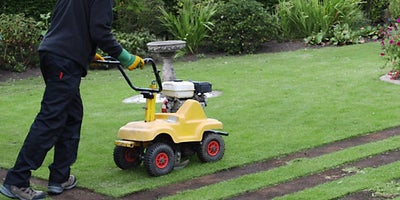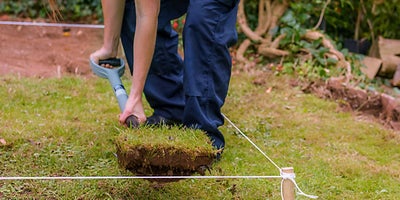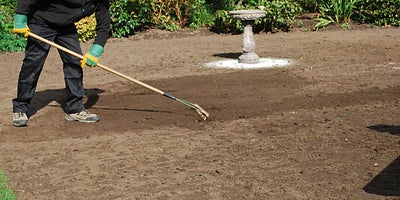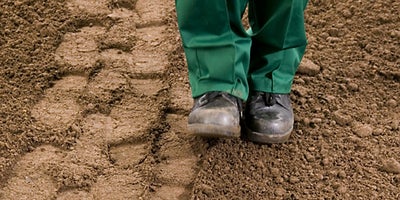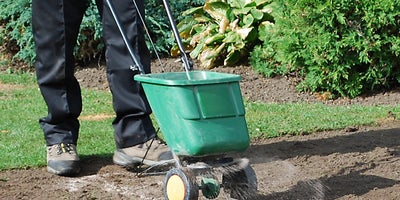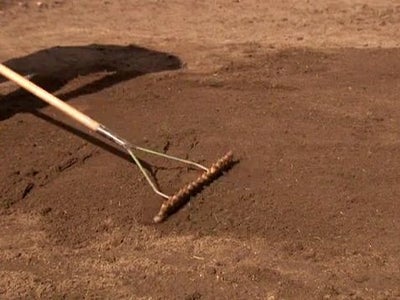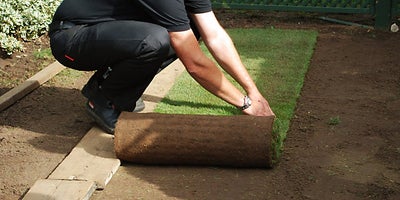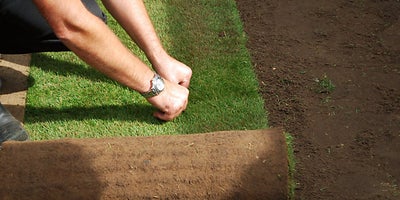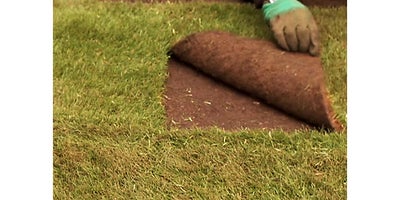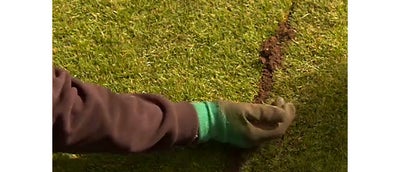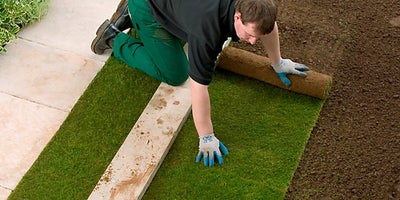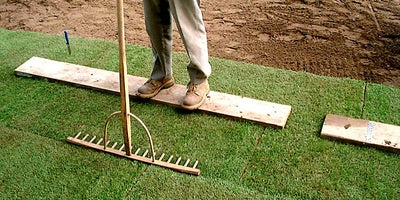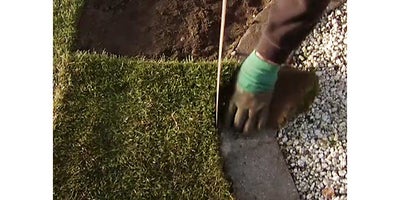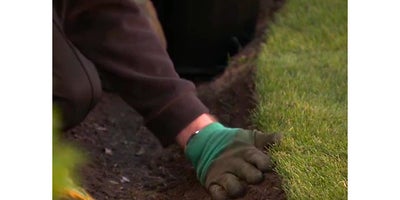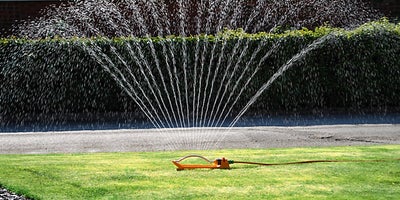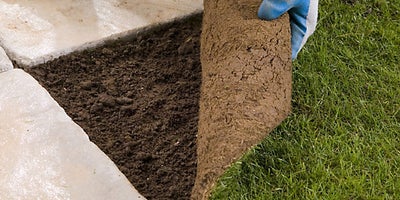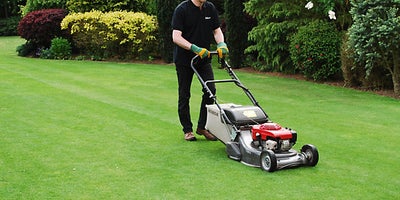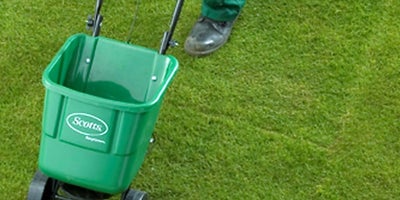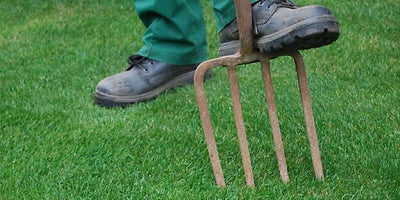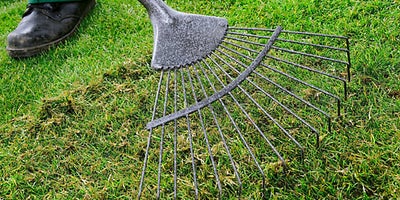Laying a new lawn
A lovely soft lawn, ideal for play and relaxation, is the centrepiece of a garden. It forms a foundation around which borders, flower beds, shrubs and paving can be planted or built. Fortunately it’s relatively simple to lay down turf, providing the area has been thoroughly prepared. If you follow a few key steps you will end up with a lawn that lasts a lifetime.
When is the best time to lay turf?
Turf can be laid all year round, with a couple of exceptions. Avoid laying turf during a hot dry spell, or onto frozen ground. The turf won’t bind with the soil, it won’t take up moisture, and will dry out pretty quickly. Spring and summer are the best seasons to lay turf. It’s very important that your soil preparations are complete beforehand, as turf must be unrolled and laid within 24 hours of arrival.
How to plan your lawn
If you’re laying a completely new lawn, it’s always best to plan it out. Think about how the finished lawn will look, how it will complement the rest of the garden, and how it will affect any flower beds or paving areas you want to include. Are there dry or shady areas where the turf is less likely to flourish?
Like all plants, grass relies on the water and nutrients it can draw up from the soil, so buying excellent quality turf isn’t necessarily enough to ensure a healthy lawn. Grass roots are shallow, but the soil still needs to be well prepared, so the grass draws up moisture from deeper down.
To find out what kind of soil you have, dig a test hole to check. If your soil is very sandy or free draining, add some compost or manure to help retain moisture. Alternatively, add some water-saving gel or capsules to the soil. If you have heavy clay soils, then work in some sharp grit and compost to help with drainage.
How much turf will I need?
It’s relatively simple to calculate how much turf you need. Measure the length and width of the area to work out how many square metres you need (turf is usually sold in square metres). If you’re working on a large area, or one with irregular or curved edges, then it’s helpful to divide the area into smaller rectangles and add the total area of those rectangles together. When you order your turf, factor in an extra 5-10% for wastage.
Do I need topsoil before laying turf?
Adding a lawn establishment fertiliser and water to your soil prior to laying the turf will help encourage root growth and establishment. If you are concerned about the quality of your soil, then you can add some topsoil as a suitable base for your turf. It’s advisable to consult your turf provider for expert advice on how to prepare your soil to create the ideal conditions.
How to remove old turf and prepare the soil
If you are replacing an existing lawn then you will need to remove the old turf. You can use a spade to do this, but a turf cutter will be a lot quicker and easier. The old turf can be composted, taken to your local recycling centre, or put into a green waste bin.
Next you need to dig or rotovate the soil to churn and aerate it. Dig the soil to a depth of 100-150mm and add a soil improver if necessary. For smaller areas you can use a fork to turn the soil over. Digging and rotovating is much easier when the soil is quite dry.
Rake the soil over to get a fine tilth and remove larger stones and any roots or weeds. You may need to rake the soil twice to achieve this.
The next step is to compress the soil to get rid of any air pockets and firm up the soil. Walk up and down the soil using very small steps, with the weight on your heels. You will probably have to go back and forth across the same area to make sure the soil is properly compacted.
To encourage root growth, apply lawn establishment fertiliser evenly across your prepared area. Be sure to follow the manufacturer’s instructions for the best results.
The next step is to rake fertilizer lightly into the top of the soil, and rake to a fine tilth. This will help the turf roots bond properly with the soil.
How to lay a lawn
Now that your soil is ready it’s time to lay the turf. It’s best to start off with a straight edge to lay against, or your longest border. You can use a plank as a guide, or a line pegged out with string. If you are turfing a circular lawn, start in the middle and work your way out.
It’s very important to ensure there are no gaps between the sections when you’ve rolled them out. Push the sections firmly against one another to avoid any gaps.
Lay the rows of turf in an offset brickwork fashion so that the joints are staggered. This reduces the risk of the turf drying out. But if there are any unavoidable small gaps you can fill them in as you go with a light sandy topsoil.
As you lay down each row, use a plank or board to kneel upon or to walk across the turf. You shouldn’t walk directly on newly laid turf.
To ensure the best contact between the turf and the soil, tamp down each row as you go along using your hands or the head of a rake.
If you have to turf around any obstacles such as a path, flower bed or tree, then roll out the turf and use a kitchen knife or handsaw to carefully cut around the obstacle. A sharp knife or saw should cut through the turf fairly easily.
Once the turf is laid, you can cover any exposed edges with soil to prevent them from drying out.
Begin watering the grass as soon as it is laid. This is a crucial step to creating a healthy lawn. The turf needs moisture to become established.
Continue watering regularly until the turf is well established. Water your lawn in the early morning or evening, which reduces evaporation. Continue to water your lawn even through spells of rain. The best way to check the grass is receiving enough water is to carefully lift a corner to see if the soil underneath is moist.
Your new lawn will soon need mowing, and this should be done as soon as you can mow without dislodging the turf. The easiest way to check that your turf is ready is to try lifting it. You should feel some resistance if the grass roots have bonded to the soil. The lawn may be ready for mowing within a few days, but usually it takes a couple of weeks for the turf to bond properly.
Although you shouldn’t allow the grass to grow too long before you mow it, the first mow should be with a shallow cut – there’s no need to take too much grass off the top. You can gradually adjust your lawnmower blades to cut closer to the ground once the lawn has been established for a few weeks.
If you are using a rotary mower then the turf needs to be particularly well rooted before mowing, as the updraft can cause the turf to lift. Make sure the mower blades are sharp, so they cut the grass cleanly and don’t drag the turf upwards.
How to maintain your lawn
Apply a lawn fertiliser in spring and autumn. Spread the fertiliser uniformly either by hand or with a rotary spreader.
Reduce soil compaction by aerating the soil twice a year - once in May and once in September. This will help the grass roots to grow deeper, which in turn will create a longer lasting, healthier lawn. Use a fork to aerate your lawn.
Once the lawn is a year old you can begin scarifying it with a rake to remove moss and dead vegetation. It’s best to scarify in March and September, outside the peak growing season of summer.
Sowing additional grass seed is a good way to make your turf denser, which minimises the risk of moss invading. It’s best to seed in early spring but this is usually only needed on lawns that are more than one year old.
